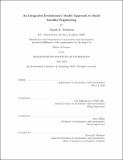An integrated evolutionary model approach to small satellite engineering
Author(s)
Robinson, Joseph B. (Joseph Brian)
DownloadFull printable version (3.832Mb)
Other Contributors
Massachusetts Institute of Technology. Dept. of Aeronautics and Astronautics.
Advisor
John Keesee and Dave Miller.
Terms of use
Metadata
Show full item recordAbstract
A deficiency exists in the use of detailed integrated modeling in the design, fabrication, and operations of small satellites (<180kg). This need led to the design of the Integrated Evolutionary Model (IEM) approach to small satellite engineering. The IEM approach uses integrated modeling throughout the satellite design life cycle to support the verification and validation of the satellite capabilities and limitations. This thesis describes the IEM approach and introduces its products: a detailed command-based integrated simulation (SIM), telemetry and data analyzer (TDA), and a mission assurance tool (MAT). Recently developed integrated systems models for the MOTV and CASTOR satellites are described and critiqued against the IEM approach, and a new simulation framework is developed for CASTOR utilizing the IEM framework. The development and use of a TDA for the FalconSAT-3 satellite is also described. The thesis presents several FalconSAT-3 operational events where the TDA was paramount in identifying and characterizing unexpected on-orbit behaviors during spacecraft and experiment operations. The utility of the IEM products is demonstrated through the successful use of the FalconSAT-3 TDA in these events.
Description
Thesis (S.M.)--Massachusetts Institute of Technology, Dept. of Aeronautics and Astronautics, 2010. This electronic version was submitted by the student author. The certified thesis is available in the Institute Archives and Special Collections. Cataloged from student submitted PDF version of thesis. Includes bibliographical references (p. 183-185).
Date issued
2010Department
Massachusetts Institute of Technology. Department of Aeronautics and AstronauticsPublisher
Massachusetts Institute of Technology
Keywords
Aeronautics and Astronautics.